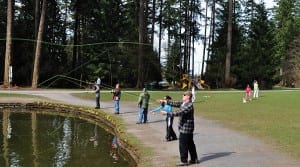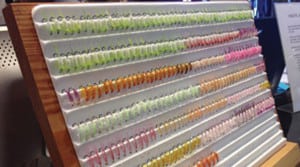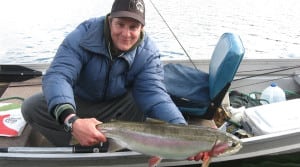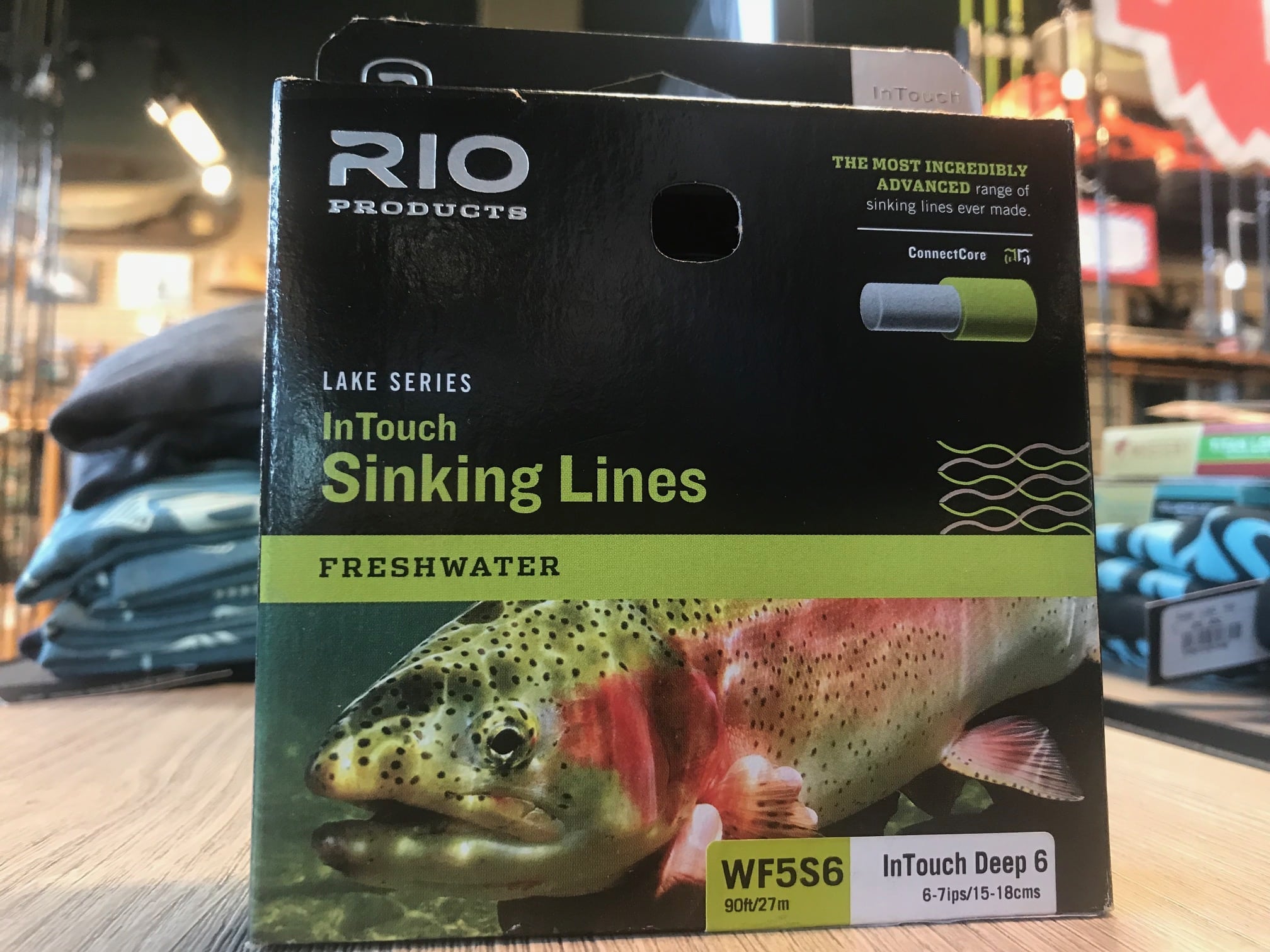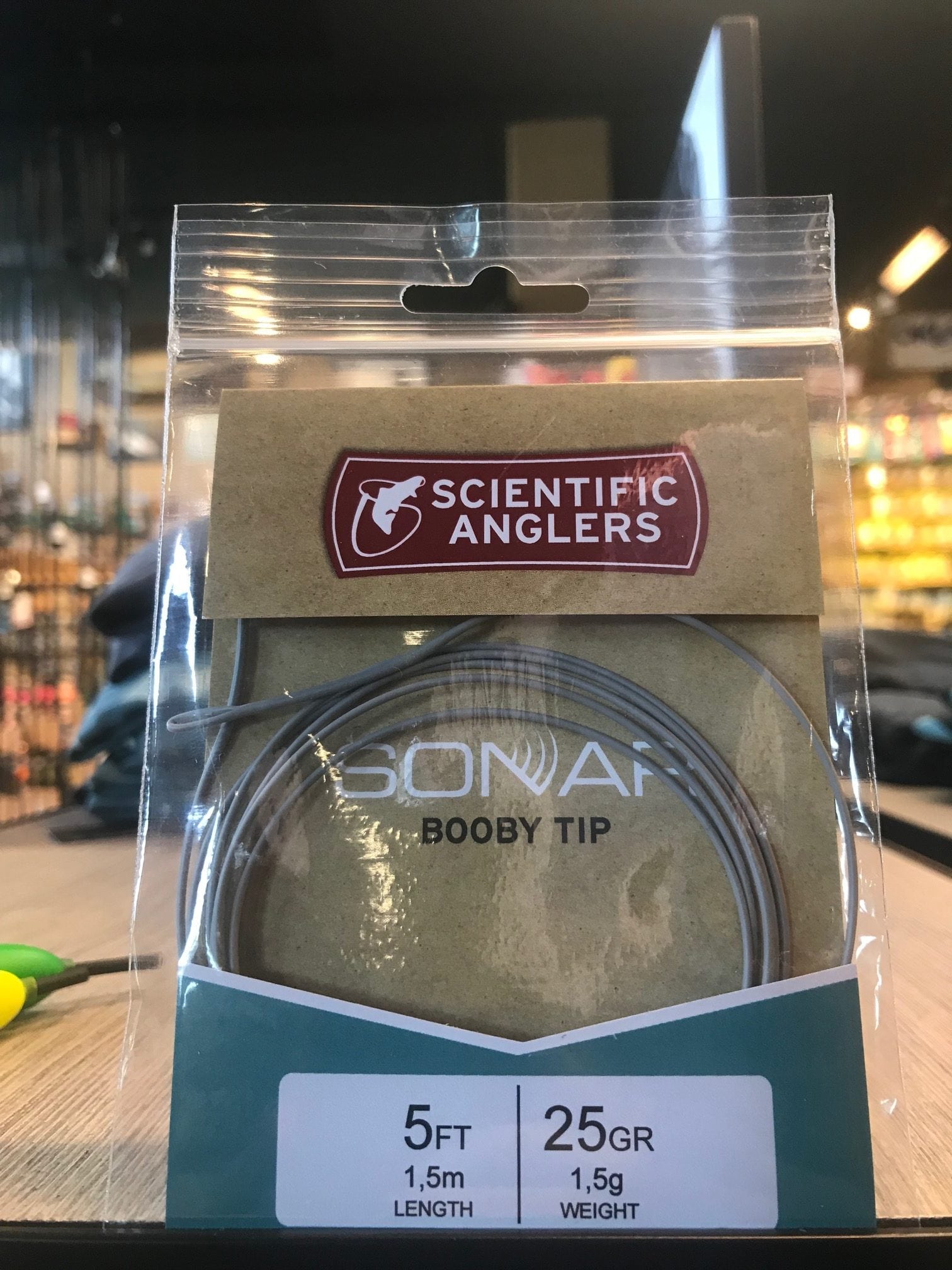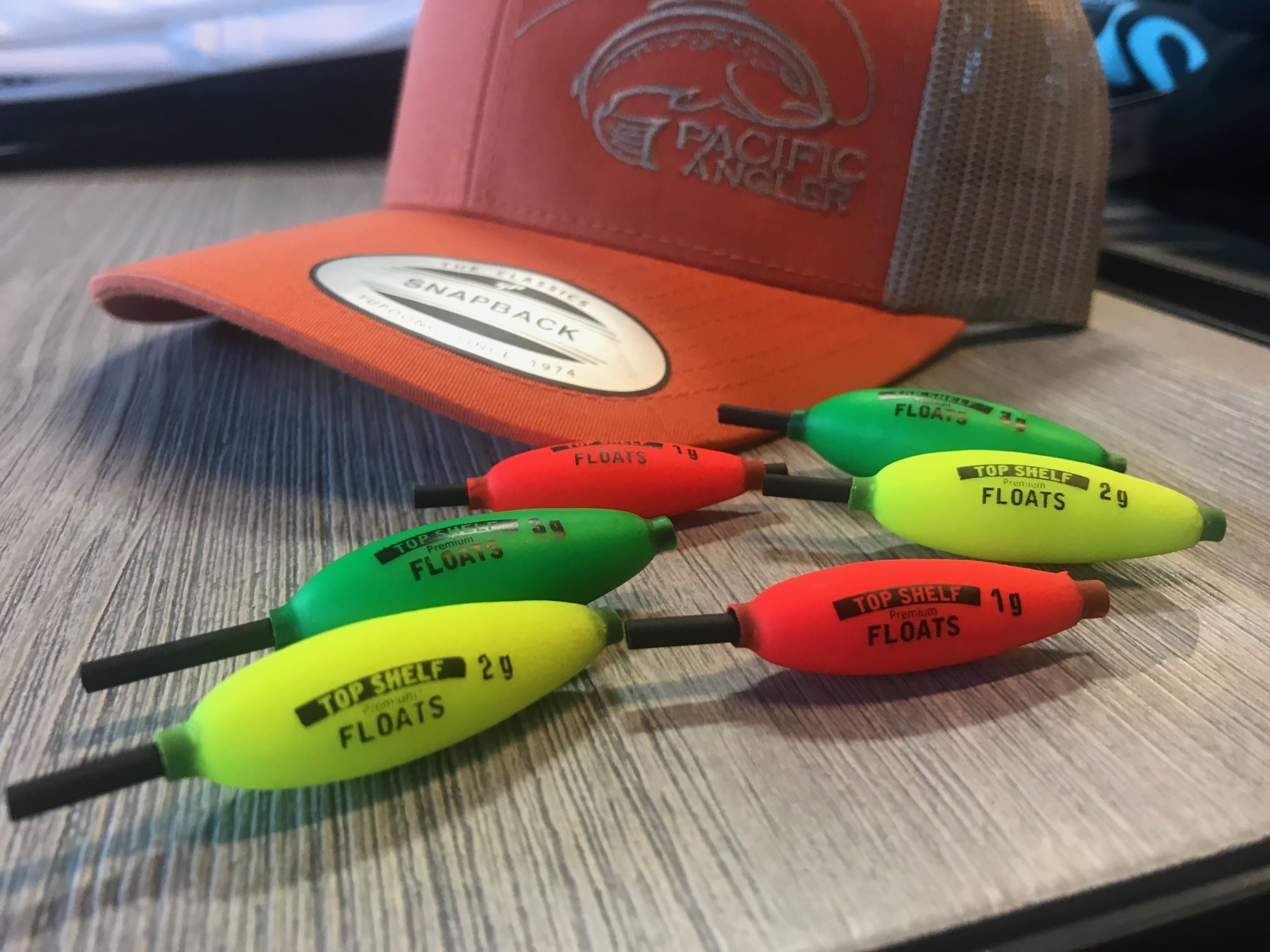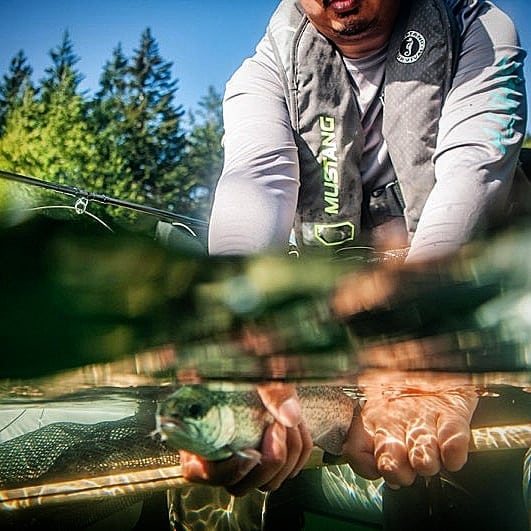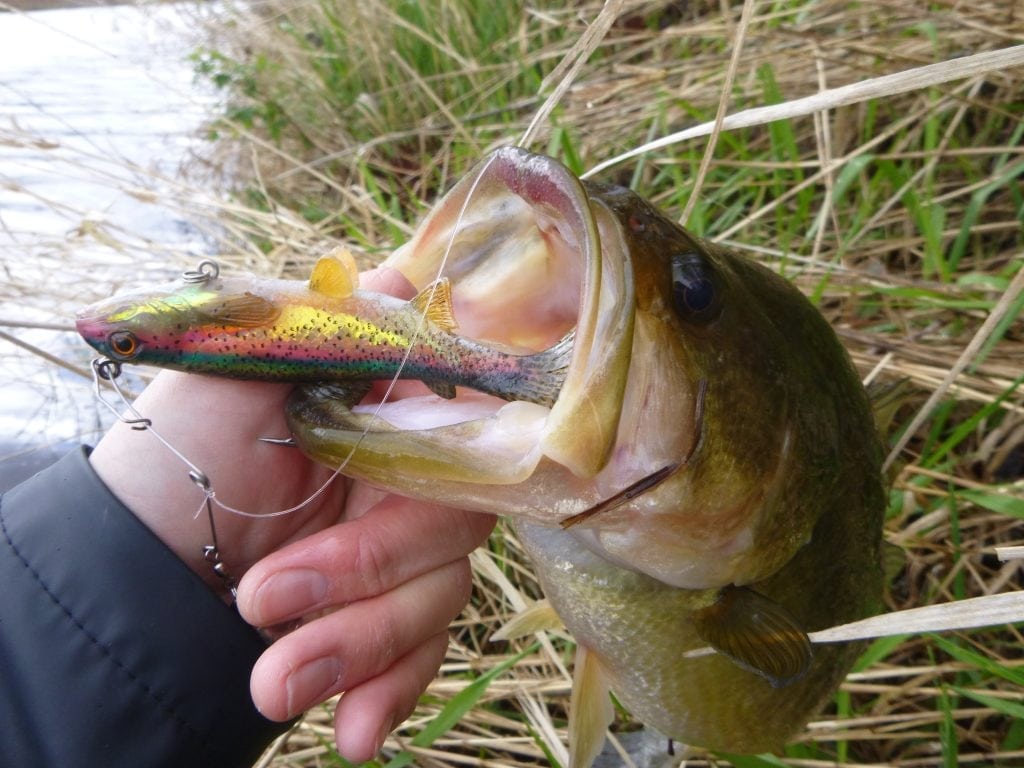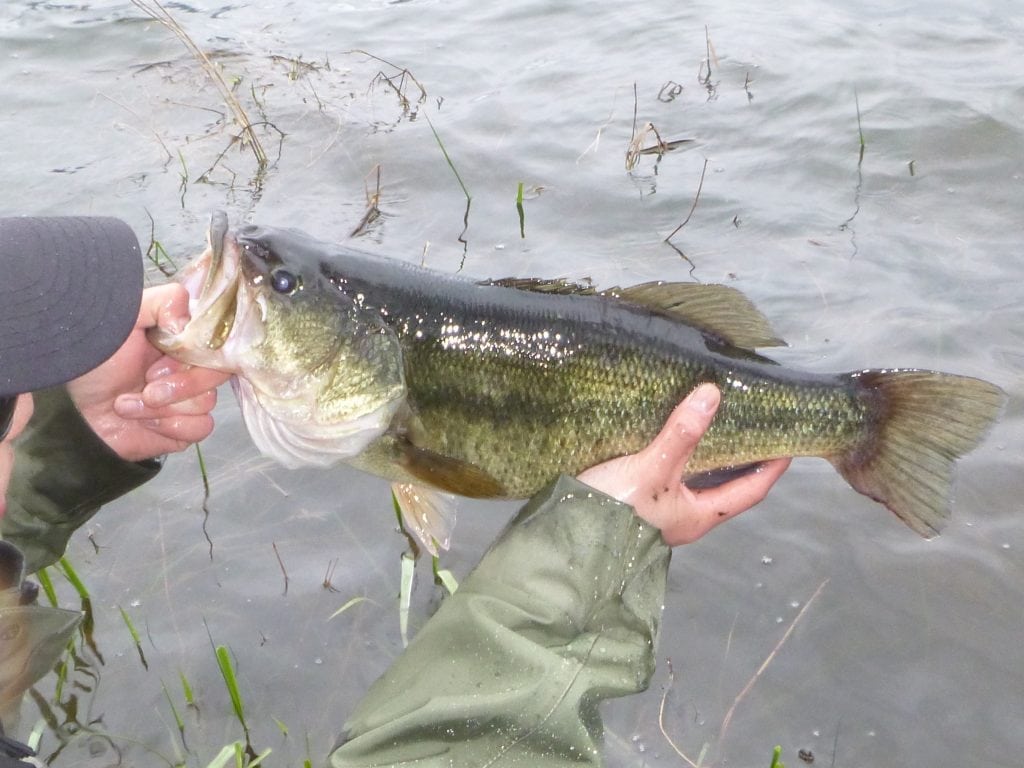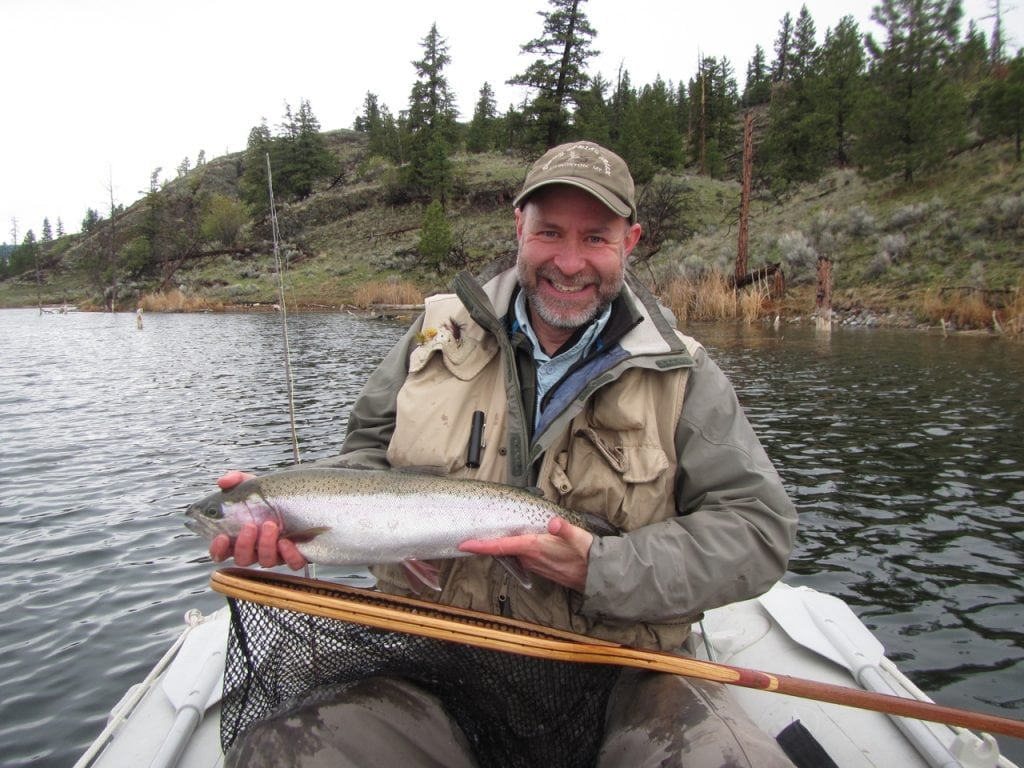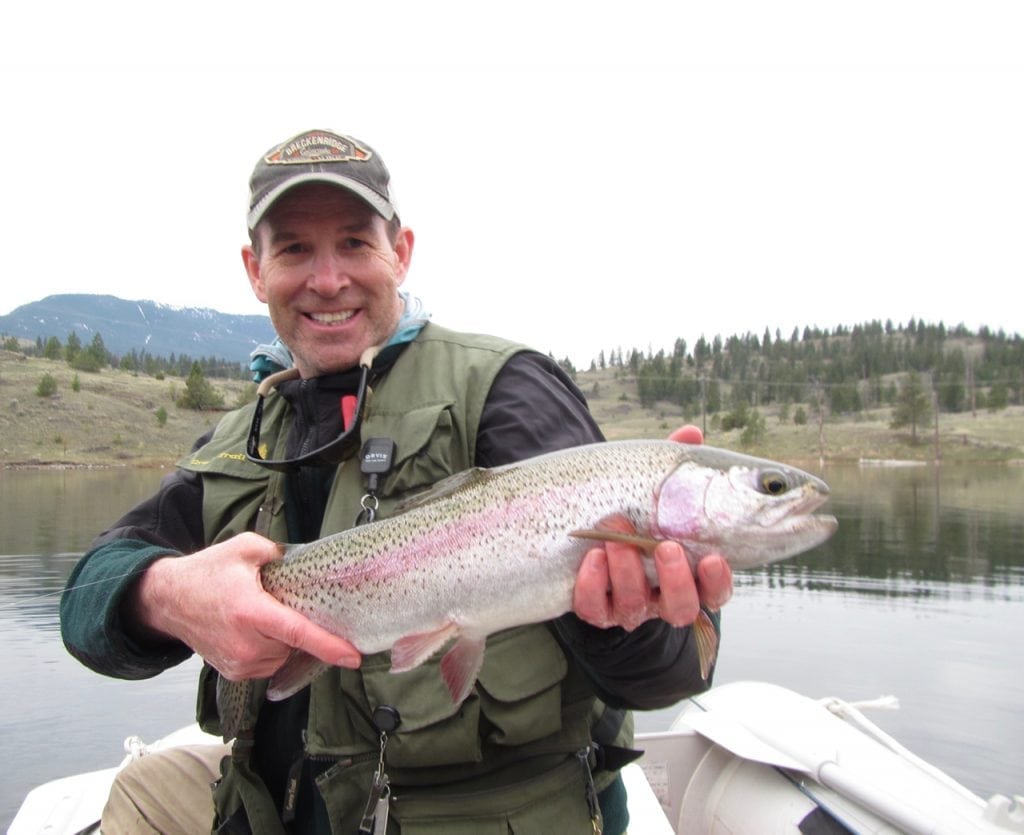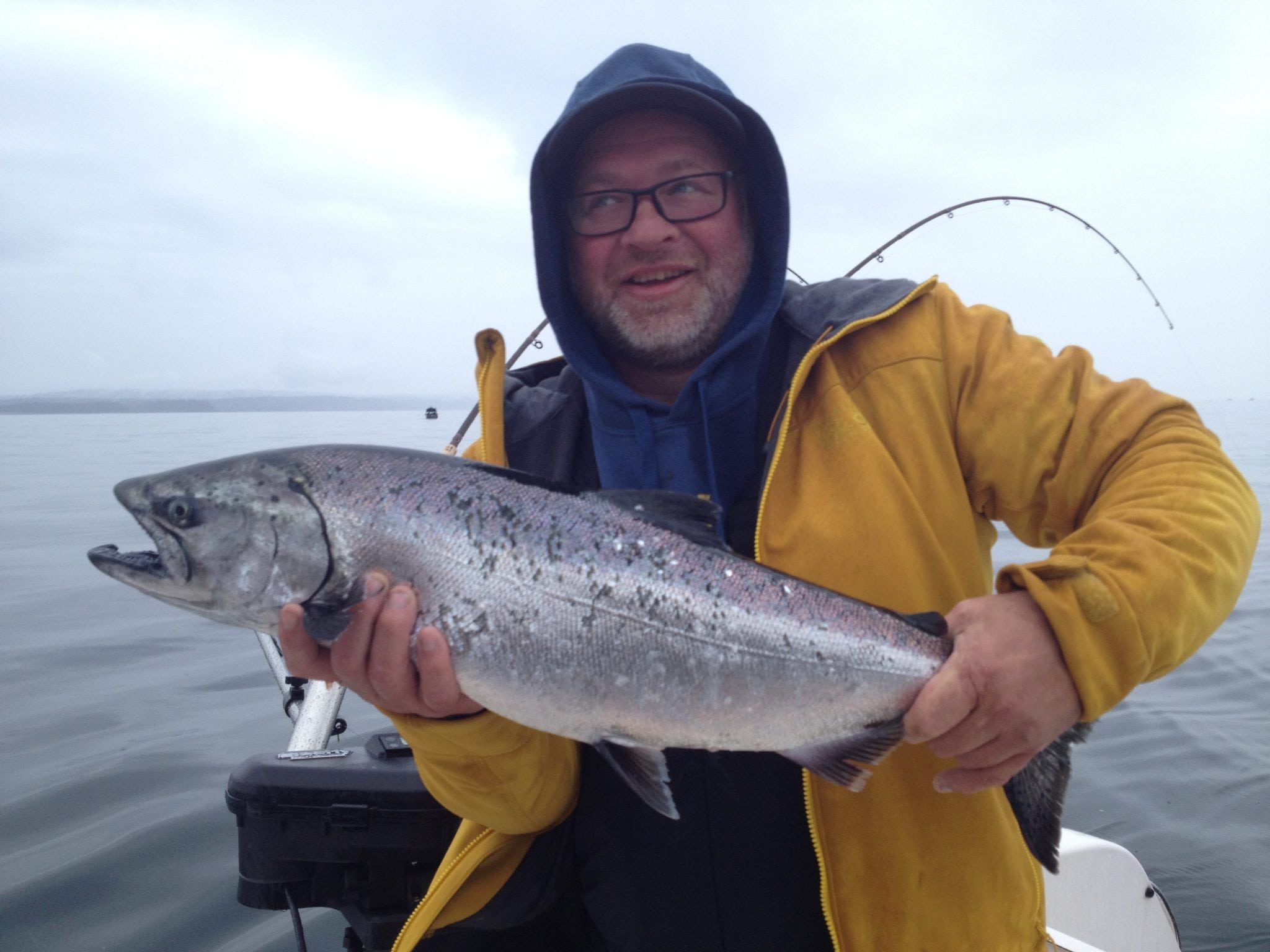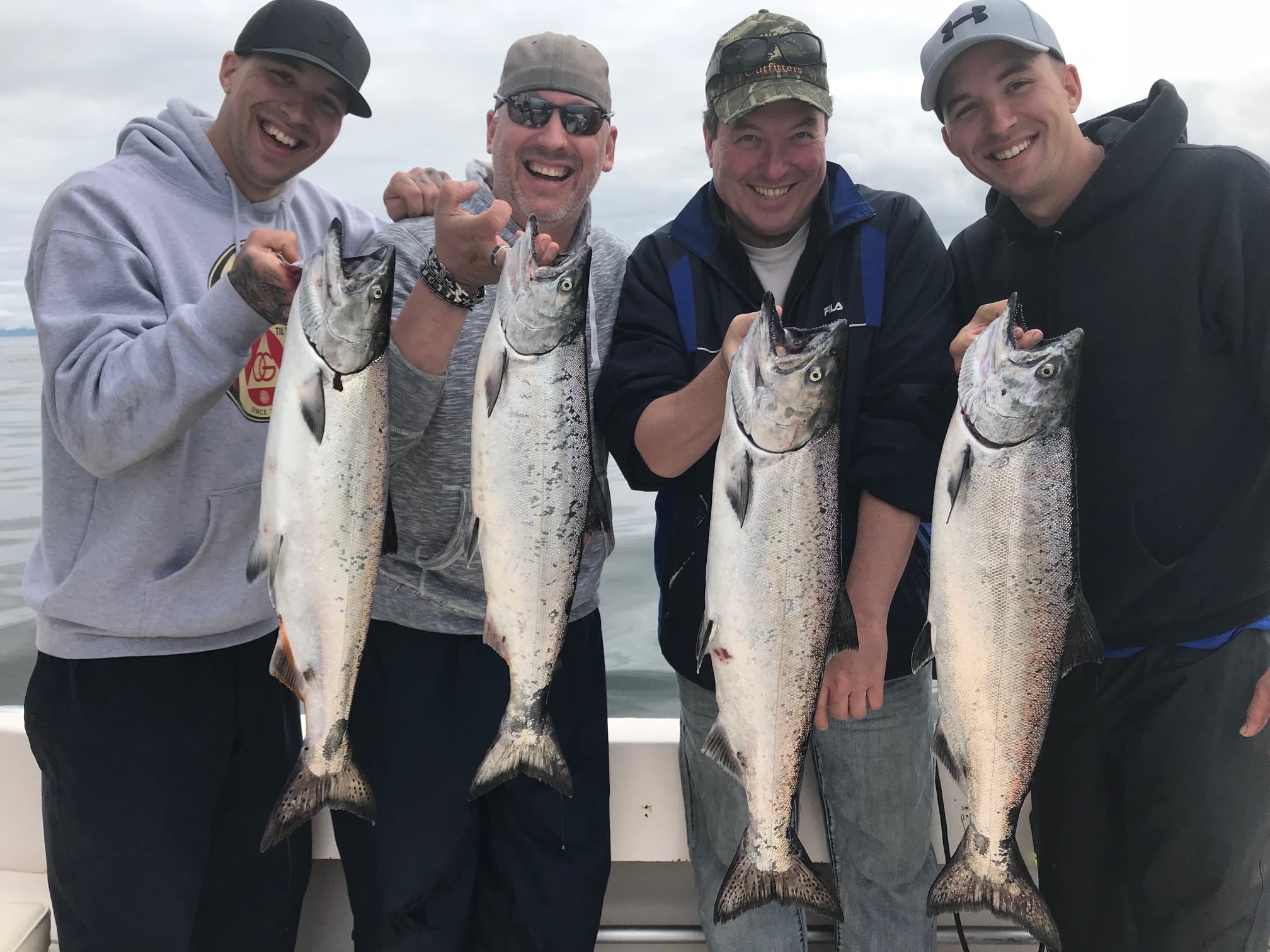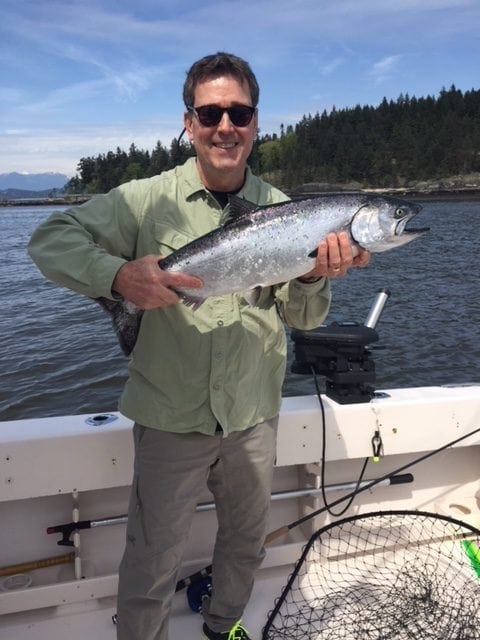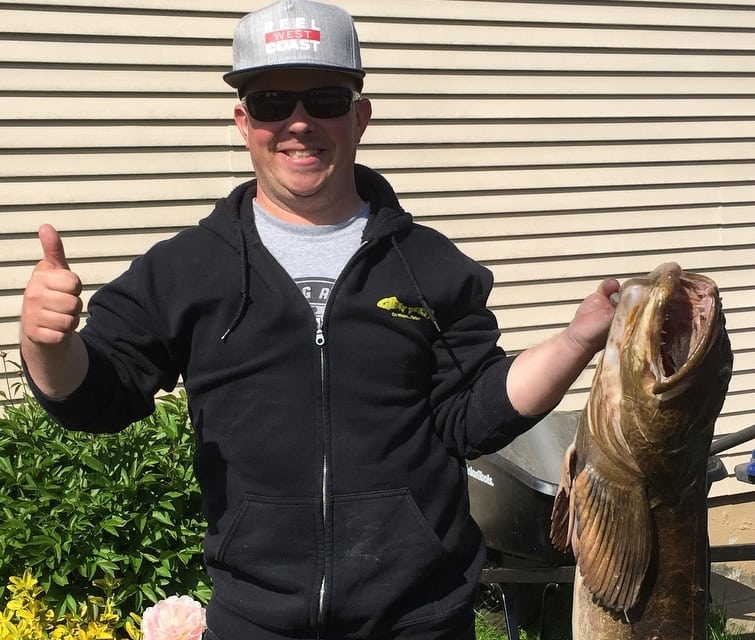OUTLOOK
Welcome to the first Friday Fishing Report of May. We’re looking forward to the start of another month of great fishing.
This past week saltwater anglers enjoyed another week of excellent fishing! Anglers who fished locally found fish at the QA, The Hump, South Bowen, and even a few were found in the harbour by those who stayed close by.Across the way, anglers were finding fish in the Gulf Islands, as well as up at Thrasher and off shore on The Highway.
As some of our local river fisheries begin to wind down for the season we are thinking about lakes. Numerous interior lakes are fully iced off with many more to come. Andre has an overview of Interior Lakes while Jordan has a report a little closer to home on the Squamish/Whistler area lakes. This week Matt will take you through some cool new lake products with a specific focus on fly lines. Check out all of the details below.
This month you can also join Matt in his in house seminar on Fly Fishing Lakes. All of the specifics on that course as well as our other May courses can be founds in our classes + courses section below.
We’ll see you in the shop or on the water this weekend!
CLASSES + COURSES
There is ONE spot left in Matt’s Introduction to Fly Fishing course. Call the shop to get this last spot! We’ve also got two of our most popular classes coming up this month; Tying Beach Fly Patterns and Introduction to Fly Fishing Lakes.
Introduction to Fly Fishing
This course was specifically designed to give the new fly fisher the basic knowledge, casting skills and fly fishing strategies to effectively fish our local BC waters. This course is comprised of two sessions; 3hr evening seminar and a 3hr casting session.
Dates: Seminar: May 9 Casting: May 12
Seminar Time: 6:30pm – 9:30pm
Casting Time: 10am -1pm
Cost: $125+GST
Tying Beach Fly Patterns
Join Pacific Angler for a 3hr evening seminar of tying flies specific to catching salmon on our coastal beaches. Without a doubt, fly selection is critical while beach fishing.
These flies are often not commercially available, so successful beach anglers learn to tie their own patterns. Your instructor will walk you through each fly pattern step-by-step.
This Tying Beach Fly Patterns course is suitable for fly tiers with a basic knowledge. Students are required to supply their own vise, tools and materials. A 10% discount is available on fly tying materials and tools purchased for the course.
Dates: May 28, 2018
Cost: $45.00+GST
Time: 6:30pm – 9:30pm
Introduction to Fly Fishing Lakes
This course will give you an in-depth look at the fundamentals of fly fishing lakes. We explore equipment, techniques, major insect hatches and ideal lakes to begin with. You will learn all you need to plan your next successful lake trip to one of BC’s 5,000 lakes! This course is comprised of one 3hr evening seminar.
Cost: $45.00 + GST
Dates: May 29, 2018
Time: 6:30pm – 9:30pm
FEATURE – YOUR LAKE LINE ARSENAL
Lake season is in full swing. We have been hearing solid reports from all the major lakes that are ice off and many more are close. You can check out Andre’s Interior Lake Fishing Report for all the specific details but today we are going to look at some cool new lake products and specifically fly line strategies for lake fishing.
A lake fisherman’s line options are kind of like his arsenal. Having the ability to change lines for the conditions is key and there are some interesting new lines for 2018 specifically designed for our interior lakes.
To start I will look at basic lake lines you will want if you are just getting into the game but farther into this article we will take an in-depth look at some of the more advanced lines that have characteristics specifically designed for our interior lakes.
The Basic Lake Line Setup
If you are lake fishing this spring you will want to have the ability to troll and find fish, to cast with a sinking line to shallow shoals and then to indicator fish or chironomid fish.
If you are on a budget or just getting into it, the best lines to look at are the Mainstream Lines from Rio. They are basic but they are very nice casting lines and work exceptionally well for their price. You will want to have a floating line for the indicator fishing, a type 6 sinking line for the deeper casting and trolling and then an intermediate line.
Intermediate lines are very useful in early season because of how the oxygen content it distributed in the lakes. When the ice is on the lake the highest oxygenated water is right near the surface and this remains true after ice off until the lakes turn over and heat drops the oxygen content in shallow areas. This means you will find fish shallow right now. Casting a floating line works with small leaches and your standard shallow chironomid rigs but being able to get down about 4-8 feet with a sinking line is very productive. The intermediate line is the best for this scenario because it will sink at 1-2 inches per second but when you start retrieving the line it stops sinking. This gives you the ability to keep it off the bottom and hover it over shallow edges or weeds where a type 3 or type 6 sinking line will snag. The Mainstream is the best cost effective line in this class. All the Mainstream lines run $52.99.
Ok, so the Mainstream lines are the best starter lines but if you are in love with lake fishing there are lines specifically designed for lake fishing. Simply put these lines do the job “better” but sometimes it can be complicated to understand how they will benefit you on the water and in some instances marketing makes things confusing. Below are our recommendations for more advanced lake lines and I have taken a close look at the design features to cut through the marketing hype.
The first line that many anglers look to upgrade when lake fishing is their floating line. Chironomid fishing or Indicator fishing is debatably the most productive way to fish our Interior lakes and casting an indicator, though always a bit of a challenge is actually not that hard for even a beginner to pull off. This year Brian Chan “The Godfather of Chironomid Fishing” is fishing the new Scientific Angler Titan Long Indicator Line. This line has a very punchy front taper designed to kick over the large indicators but is also “long”. The 43ft head allows for better role casting and keeps the line more stable with longer casts when trying to carry a wide open loop. You need an open loop to stop the long indicator leaders from tangling. This line is also heavy for its’ line class. At 185gr in a 5wt it is almost a line and a half heavier than the standard. Again this makes it easier to load the rod when role casting or during slow moving wide looped casts. If you are looking for a dedicated indicator line come down the shop and ask to see the SA Titan Long. It runs $110.
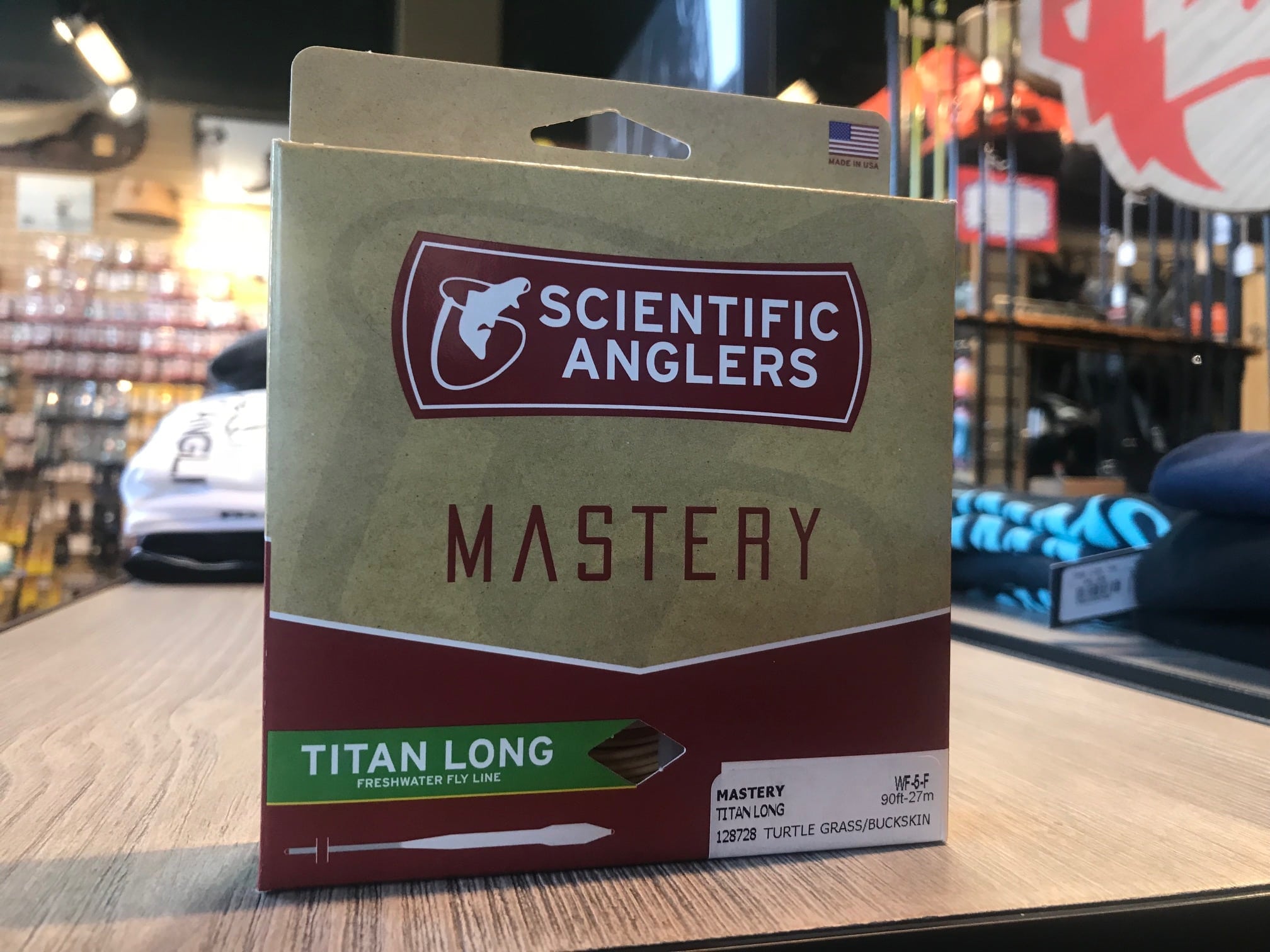
The SA Titan Long – A go to indicator line with the same punchy head as standard indicator lines but with better handling long head for casting wide open loops.
The second line that most people upgrade is their intermediate line. Again, this year Scientific Angler has improved their clear camo line. I had a chance to cast this line last week and was blown away by how little it coils. Coiling has always been a problem with the clear intermediate lines. The clear material is notorious for being a coiling, tangled mess. The Sonar Stillwater line in camo clear is the best line I have cast in the category. It has a mixed camo clear colour that reduces sun glint and has a 32 ft head perfect for loading fast and then shooting with a tight loop. It is 160 grains in the 5wt this makes it a touch heavier than the standard 5wt line but not too heavy. You will actually find when you are trying to go for distance, if you over line too much, your cast will be unwieldy at 50+ft. A beginner might consider over- lining but for most intermediate and advanced casters, I would recommend going with the standard line weight when matching up the Sonar Stillwater line.
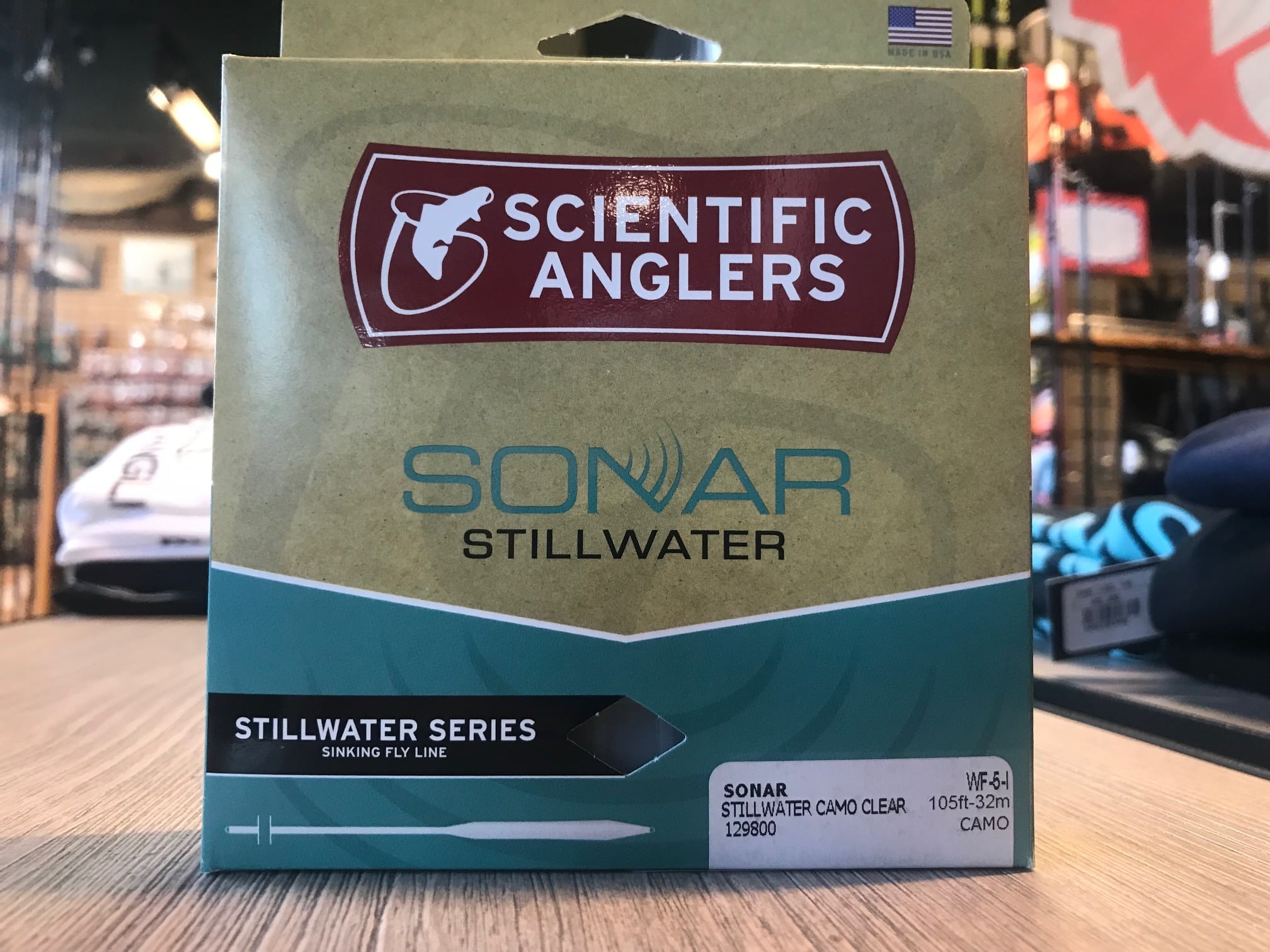
The SA Sonar Clear Camo Lake line – The nicest coil free finish that we have seen in an clear camo Line.
The last line that you might consider upgrading is your heavy sinking line. If you are just trolling with it, we recommend sticking to the cost effective Mainstream lines but if you are into casting dragons or leaches deep or if you are booby fishing where you want your line right on the bottom and then the fly to rise up, we recommend the Rio InTouch Deep 6. The Rio Lake series have an InTouch core. This means they have no stretch and it allows you to feel every bite or tap from the bottom. The other feature that we love about this line is they put a “hang marker” 13 feet from the front end of the line and it shows anglers when to stop stripping and to fish the “hang”, and when to recast. I really like this feature as it gives a visual indicator as well as a tactile reminder when the raised “bump” of the marker goes through the first guide so you don’t strip in too far. The Rio InTouch Deep 6 is designed with a short 21ft head, that loads the rod from the first cast and results in long distance with a minimum amount of false casts. The Rio InTouch Deep 6 is $103.95
That is all we have on lines but we also have a couple cool add on lake accessories. The first is the new Scientific Anglers Booby Tip. This is an interesting idea. It is a 5ft 25gr floating tip that you loop onto you type 6 sinking line. This helps rise up the booby fly from the bottom above the weeds. You could also use this tip with other non weighted flies and achieve a similar presentation hovered above weeds on the bottom. A product I am excited to experiment with especially a little later in the season when the weed beds grow.
The last new items we have brought into the shop for this lake season are the Top Shelf 1, 2 and 3 gram indicator floats. These were designed for gear fishing bait rigs but fly fisherman have adopted them to indicator fishing because they cast surprisingly well for their size and tip up when a fish is biting them giving you a great visual que to set the hook.
If you are gearing up for lake season come down to the shop and we can show you all the new toys. If you are heading out now keep sending in the reports and the fish pictures!
Matt Sharp
FRESHWATER FISHING REPORTS
Chilliwack River Fishing Report
We are into our fly fishing only month on the Vedder. Unfortunately the water has been on the high side with not the best clarity and this will most likely continue through most of the month as we see higher temperatures and potential snow melt.
For those wanting to give it a try still, swing big streamers to get noticed in the murky water. Heavier sink tips may be needed with the high water. Keep an eye on the hydrograph and you can capitalize on a few days of cooler weather we may see better conditions for fly fishing. There are still fresh fish coming in so it is definitely worth one last shot before it closes in June.
Alex Au-Yeung
Squamish River and Squamish Area Lake Report
Bulltrout fishing has continued to be decent this past week even though the river has clouded up and is high. With more warm weather on the horizon the days are numbered for fishing on the main stem Squamish. The river has been cloudy all week but not too high. It is sitting at a 3.5 on the graph as we write the report and though this is a challenging level to cross and move around the river it is not game over yet. Our trips have been consistently pumping out bulltrout. The tributaries have also risen but are worth a look. We are fishing larger flies to combat the coloured water and large spoons and spinners are still very productive in chartreuse, oranges and greens.
With the shift in weather it is still worth getting out but watch the water levels. I would assume that anything over a 4 on the graph is too high. Have a backup plan. Pack the float tube in the car, check out the river and hit the Squamish lakes if the river is too high.
The lake fishing in the Squamish area has been on and off, depending on whether the lake is turning over.
Stump Lake had some ideal conditions, but we did not see any signs of fish life. There were huge midge hatches coming off and lots of daphnia, but again, between four us, not a single touch.
Alice was in the middle of turning over. Zach did connect to a couple fish, but none stayed on the line. Small black and chartreuse leeches were what interested those few fish.
After moving around to a couple different lakes, we settled on another small lake nearby. This lake proved to be the winner. It turn on and all four of us were consistently getting into fish. I found that stripping small pregnant scuds near the weed beds was the most productive, as well as searching around with small olive patterns such as a ’52 Buick or micro leech.
Hopefully the lakes will all start to produce and we will hear of some more productive reports.
Remember, if fishing from a watercraft, a PFD should always be worn. We’ve got some great Mustang collars in stock so come in and check them out. You can’t show off fish pictures if you don’t make it back to the dock.
Jordan Simpson
Bass Fishing Feature
Are we finally out of that winter slump? It sure looks that way, and with rising temperatures the winter fisheries are on their way out and t-shirt weather fisheries are on their way in. One such fishery is for spiny-ray fish such as bass, sunfish, and crappie. These species can be caught year-round but get the most active when the water warms up. They are all fun to hook, but for this report I will predominantly focus on the local largemouth bass fishery in the Lower Mainland.
Anyone who has ever turned on their TV and watched a fishing show with Bob Izumi or Bill Dance has seen bass fishing in action. It seems like such a foreign thing here on the West Coast but the fact of the matter is that we do have a bass fishery here in British Columbia. Not only can they be found in the Interior and on Vancouver Island but Bass also inhabit a number of different waterways in the Lower Mainland. In the warmer months they get very active and the smaller specimens can be great fun for kids or those just getting into fishing while the larger fish can present a very technical fishery.
Bass fishing is very different from the salmon/trout fishing we are used to here, so if you go into it with that same mindset you will be pretty disappointed. True bass gear is quite specialized; I’d say “niche” but it really isn’t when you consider that it is sold throughout most of North America. Can you catch them just cranking your typical salmon/trout spoons and spinners through the water? Totally. You can catch them on a bobber and worm if you want. But to get truly dialed in the “bass gear” is the way to go. There are so many options when it comes to bass rods, reels, and lures. We’d have a hundred pages of information here and it still wouldn’t get down to the nitty gritty of it. I’ll spare everyone the pain and give you the TL;DR version (“too long, didn’t read”).
When it comes to rod/reel setups, a light to medium powered 6′-7′ spinning rod will do for open water, while medium to heavy 7′ spinning or bait casting setups are much more apt for catching them in heavy cover. Line variety covers a huge range, from fluorocarbon top shots for finesse fishing for clear-water fish to heavy braid for winching them out of the thickest snags you can imagine.
You will see both topwater lures and subsurface lures for bass. Topwater lures are, you guessed it, fished on the surface and are great for fishing up shallow. Both poppers and hollow-bodies are your lures of choice for this. Generally, poppers are for open water while but hollow-bodies are weed less lures that you can fish in super thick weeds without getting snagged as the hooks are flush with the rubber body. They mimic thrashing mice, frogs, or dying baitfish that present an easy meal for a Bass.
Subsurface lures encompass a much wider variety of presentations, but some of the more popular ones are spinnerbaits, swimbaits, crankbaits, and texas rigs. The first three are great for covering water and looking for active fish, while the texas rig is fantastic for crawling soft plastics along the bottom through thick weeds, rocks, and wood as it is rigged weedless. Again, in the interest of keeping this relatively short come on in to the Shop and we would be happy to explain more in depth as to how to use these presentations.
I can already hear some of you asking, “but where do I find these fish?” Admit it, some of you skipped down to this section as it’s the juiciest part. As mentioned before there are a number of places that hold bass, and some of them you will probably be surprised by. There are definitely more places than most people would think. I’m not going to name all of them but here are a few to get started.
- Deer Lake (Burnaby)
- Burnaby Lake (Burnaby)
- Mill Lake (Abbotsford)
- Albert Dyck Park (Abbotsford)
- Hatzic Lake (Mission)
- Chadsey Lake (Sumas Mountain)
There are quite a few more but these will get you started. This is the time of year when you want to start looking. It gets easier to catch good numbers when the water warms up so after a few days of sunshine is a great time to head out there. Come talk to us at the Shop if you would like to know more. We just got a nice spread of bass gear in so come take a look!
STILLWATER FISHING REPORTS
Local Lake Fishing Report
The local lakes have been more consistent as the weather warms up and the bugs are hatching. If the warm weather continues we will see things start slow in the middle of the day. I have noticed it is more consistent just before the sun hits the water or just after sun is off the water. All the lakes have been stocked and you can get the most recent data on gofishbc.com.
Because it is a lot warmer, dry fly fishing is now a viable option. In most of the local lakes the natural flies are small and dark. You can match the hatch and might have success but if in doubt a Royal Wolf or Coachman is a great attracter that usually hooks fish.
It is also a great opportunity to practice chironomid techniques. You can go to deeper lakes like Deer Lake or Buntzen Lake. Small gun-metal or black chironomid patterns and small dark micro leaches will always produce.
As always spoons, spinners and bait is a great option as well! As I have mentioned before it is important to try everything to see what they are keying on. We have a good selection of micro floats and different power bait to try so come down to the shop and we can help.
Have fun,
Dustin Oh
Interior Lakes Fishing Report
A few lakes that are iced off of for sure already are: Jacko, Stump, Roche, Edith, Courtney, Logan, Morgan, Marquart, Lundbom, Corbett, Six Mile, Dragon . If you are eager to go, these lakes should be fine. I am sure there are other ones that have iced off but there is still a chance that you might hit a turn over. I will have more solid report after this warm week ahead of us.
- Thanks Mark for the pictures.
- Looked like a great early season trip!
Although the water temps are still below 45 degrees in most of the lakes there are some minimal hatches of chironomids during the warmest part of the day. They are usually in the size 16-18 range so make sure you have some this small in you box. The fish will also be in the shallows so fish leeches under a strike indicator and also try your luck fishing scuds with a floating line or a clear intermediate line hugging the shoreline. This should sum up the food source for now until the lake temps rise. It is too early to know which lakes are winter killed as it is easier to detect this after a lake is turned over so I will have a list of lakes a soon as I hear of any.
Andre Stepanian
SALTWATER FISHING REPORTS
Vancouver Saltwater Salmon Fishing Report
This past week saw some great fishing for those who were able to get out. Anglers who fished locally found fish at the QA, The Hump, South Bowen, and even a few were found in the harbour by those who stayed close by.
Across the way, anglers were finding fish in the Gulf Islands, as well as up at Thrasher and off shore on The Highway. With the water being quite a bit more clear over there, anglers have been encountering fish anywhere from 130′ all the way down to 180′, especially on those brighter days.
With most of the bait encountered being bigger, most anglers are finding success with spoons in the 4.0-5.0 range. Though bait and spoon size has been increasing slowly, most of the spoon colours have remained the same. Kingfisher spoons in Irish Cream, Cookies and Cream, Homeland Security, Kitchen Sink, and Herring Aide have all been great choices, along with the Two-Face series as well.
From Gibbs, the Skinny G and G-Force spoons in 4.0 have been great. Similar colours as mentioned above are all great choices, including Trap Shack, Outfitter, BC, and Paddy Wagon.
If over at Thrasher, don’t be scared to run bigger cuttlefish and double-skirts as well, as it was noted earlier in the week that the fish took some more interest in them over your standard 4.5 Hoochie.
Flasher choice has also played a role, with most anglers trending towards blade colours in green, chartreuse, black, and UV purple. Combinations of those colours mixed with UV tape and glow complete the flasher, making the Phantom series a great choice. Some other top favourites are Chartreuse UV-Glow, Madi, Green and Purple Onions, Club Dub, Salty Dawg, and CB55. Those these are some great flashers, they are not the only ones out there, so it doesn’t hurt to experiment. If you’re looking to round out or add to your collection, we carry a huge selection, and any one of experienced team members can help you out.
On days like today (or any day for that matter), it doesn’t hurt charge up your spoons and flashers before putting them down. A small UV light is a great accessory to keep with your gear, and is easy to keep in your pocket or out of the way.
Keep in mind that with the lingcod fishery now open over there, that jigs, swimbaits, and paddle tails are all great choices. We carry a large selection of them in various sizes and weights to help match the conditions.
If you have any questions, feel free to come on down to the shop – we’ll be glad to help!
You can even ask me about my special way of setting up jigging rods for bottom fish.
Tight lines,
Jordan Simpson


